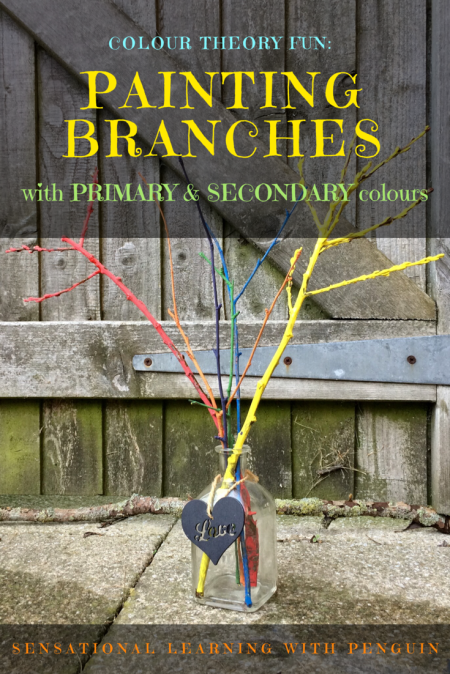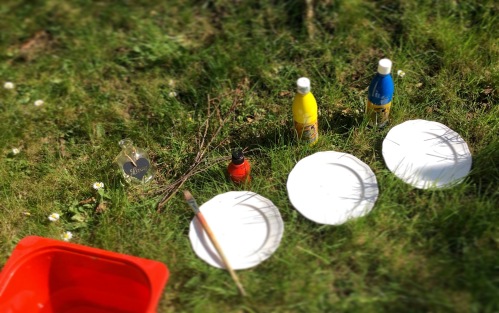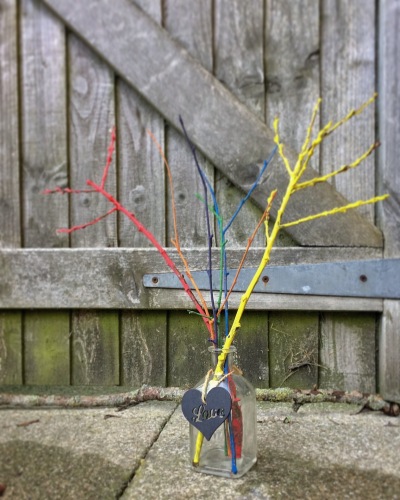Yesterday we did a simple colour theory activity, inspired by some of the pretty ‘Easter trees’ that I’ve seen pictures of online recently. I’ll have to admit that we haven’t decorated much for Easter this year, so I thought it was high time we made some kind of colourful decoration to brighten up the place with. And as it was a beautifully sunny and warm day, a garden activity seemed ideal.

This whole activity is super simple, and all you need is:
- A minimum of six branches (we used ones we found on the ground in our garden, and as we had a small vase/bottle in mind for putting them in, we went for six small ones).
- Acrylic paint in red, yellow and blue.
- Three dishes for the paint.
- A paintbrush, or just use your hands, and a bowl/bucket of water for washing your brush/hands between each colour.

We started off by squeezing some red paint out onto a dish, and then applying it to one of our little branches. We then did the same thing with the yellow paint, and the blue.
Squeezing paint out is great for exercising hand strength. And if you choose to apply the paint to the branches by hand, this activity also becomes a very tactile sensory experience. Using a paintbrush on the other hand is a good way to practise pre-writing skills, tracing the shape of each branch.

Once we’d done red, yellow and blue, we stopped to take notice of the fact that these were primary colours. We can’t get any of them by mixing other colours, but by mixing those three in various combinations we could get almost any other colour. (Just as a side note: when mixing colored light or shining light throught filters, the primary colours are not the same as when mixing paints.)
As Penguin is non-verbal, but does show some interest in using spoken words, I also asked him to name the colours, just to sneak in some speech practise too.
Next it was time to make some secondary colours, by mixing each of the primary colours with one of the other. I had placed the red, yellow and blue branches in that order from left to right on the grass in front of us, to dry. So it made sense to go for the secondary colours following the same order (as the rainbow spectrum) and start off by mixing red and yellow.
 We added red into the dish that already had yellow on it, to make orange, and painted a branch and placed it on the grass between the red and yellow. Then we added yellow paint to the blue dish, mixing it to make green, and painting a green branch. And finally we made a purple(ish) colour by adding blue to the red dish, and painted our final branch purple.
We added red into the dish that already had yellow on it, to make orange, and painted a branch and placed it on the grass between the red and yellow. Then we added yellow paint to the blue dish, mixing it to make green, and painting a green branch. And finally we made a purple(ish) colour by adding blue to the red dish, and painted our final branch purple.
That’s it! Just let the branches dry, and then pop them in a vase. Ta-daa!
You might notice that Penguin decided to paint himself too in the process, so our activity went on to involve the water hose and some soap as well…
If you’re doing this for Easter, you could of course add some decorations as well, such as egg-shapes cut out of coloured card, or feathers (preferably fake ones to avoid animal cruelty), or glass beads. Or whatever takes your fancy.
Thank you for reading, I hope you’ll enjoy this little activity! For more ideas on sensory fun and multisensory learning, take a look HERE, and please join us on social media too:
- Facebook: facebook.com/sensationallearninguk
- Instagram: instagram.com/sensationallearningwithpenguin
- Pinterest: pinterest.com/senlearnuk
- Twitter: twitter.com/senlearnuk

Linking up with:



What a simple but effective idea! I love painting outside too, it keeps my dining room table clean! Haha! I love how you introduced the colour spectrum in a fun, hands-on way that even included nature! My children would really like this activity. #KCACOLS
LikeLiked by 1 person
Thank you lovely! It’s great when all the mess can be kept outside, isn’t it? Haha 😀 xx
LikeLike
What a great idea. I too appreciate keeping the mess indoors to a minimum. Will try this now that the weather is improving #KCACOLS
LikeLiked by 1 person
Thank you lovely! It’s so nice to not have to worry about stains on floors, walls, furniture… 🙂 x
LikeLike
I adore this idea!! It is a great way to be creative and get outside. Simple, but oh so very cute! My boys would love this! Thank you for sharing! #KCACOLS
LikeLiked by 1 person
Thank you Lana! I hope you all enjoy it! Xx
LikeLiked by 1 person
I enjoy messy activities you can do with littles which gives them so much positivity and learning but are simple to do and super cheap. My son had a thing for sticks when he was younger so would of loved this. Balancing activities for a one year old and eight year old I find really tricky but the simplest ones are often the best! #KCACOLS
LikeLiked by 1 person
Absolutely agree, simple activities are often the best, and craft set ups can be great for mixed ages x
LikeLike
Great idea, I love that you use simple craft activities to teach different skills! I also love that Penguin painted himself too, something my little boy would do! Thanks for linking up to #KidsandKreativity, hope to see you back next time x
LikeLiked by 1 person
Haha, I’m glad to hear that you’ve got a potential smurf in your family too! 😅xx
LikeLike
What a great activity, one of my little ones is really into painting, he says he wants to be an artist when he grows up 🙂 Thanks so much for linking up at #KCACOLS. Hope you come back again next time.
LikeLiked by 1 person
That’s so sweet, I too used to see myself as a bit of an artist when I was little ☺️ I guess in some ways, I still do! xx
LikeLiked by 1 person
Great sensory play ideas!! #KCACOLS
LikeLiked by 1 person
Thanks lovely! X
LikeLike
what a simple and fun idea! It is a great way to get the kids outside!!
#Kcacols.
LikeLiked by 1 person
Thank you Veronica! Yes, I find we stay out in the garden for longer if we have an activity such as this to work on 🙂 x
LikeLike
I love the look of this project. I’ve seen coloured string wrapped round sticks before but not paint. Decoart paint may last longer for outdoors crafts. #mmbc
LikeLiked by 1 person
Thank you! Yes, I’m not sure these would last much if left outdoors… We’ve placed ours on a window sill 🙂xx
LikeLike
I love this! It is a great sensory activity, but also something that I would love to do.
#MMBC
LikeLiked by 1 person
I find doodling relaxing, and this has similar qualities. You just let the colours and the water take you along, sort of 🙂 xx
LikeLike
We are so doing this! The child is really fascinated by colour mixing at the moment and painting outdoors is way less stressful than painting indoors! #TwinklyTuesday
LikeLiked by 1 person
Ooh, perfect! I hope you have great fun together with this activity, and that it’s a sunny day where you are too! Thank you for your lovely comment x
LikeLike
The finished branches are actually really effective and look lovely as a display. I’d like to try this, we’re trying to work on numbers ‘one more, one less’ so maybe It would work with different shades of the same colour ie, keep adding one more squirt of white to red until you get a pale pink etc. Thanks for the inspo #TwinklyTuesday
LikeLiked by 1 person
Thank you! xx
LikeLike
What a lovely activity. I love how Penguin painted himself. My youngest always ends up with more paint on him too. x 🙂 #MMBC
LikeLiked by 1 person
Thank you Jayne! Haha, it can get messy, but it’s all good fun 🙂 xx
LikeLike